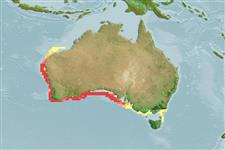Environment: milieu / climate zone / depth range / distribution range
Ecologie
marien benthopelagisch; diepte 80 - 300 m (Ref. 33839). Subtropical
Eastern Indian Ocean: southern Australia.
Grootte / Gewicht / Leeftijd
Maturity: Lm ? range ? - ? cm
Max length : 51.0 cm TL mannelijk / geslacht onbekend; (Ref. 33839)
Korte beschrijving
Determinatiesleutels | Morfologie | Morfometrie
Dorsale stekels (totaal) : 6; Dorsale zachte stralen (totaal) : 13 - 14; Anale stekels: 4; Anale zachte stralen: 12 - 13. Red with numerous horizontal white lines on sides; eyes yellow; unpaired fins reddish, caudal with broad, intensely red stripe on each lobe; pelvic fins whitish, pectorals mostly transparent (Ref. 33839).
Found on the continental shelf (Ref. 75154).
Levenscyclus en paargedrag
Maturiteit | Voortplanting | Paaien | Eieren | Fecunditeit | Larven
Gomon, M.F., C.J.M. Glover and R.H. Kuiter (eds.), 1994. The fishes of Australia's south coast. State Print, Adelaide. 992 p. (Ref. 33839)
Status op de Rode Lijst van het IUCN (Ref. 130435: Version 2024-1)
Gevaar voor de mens
Harmless
Gebruik door de mens
Visserij:
Tools
Speciale rapporten
Download XML
Internetbronnen
Estimates based on models
Preferred temperature (Ref.
123201): 13.9 - 20.3, mean 15.8 °C (based on 17 cells).
Fylogenetische diversiteitsindex (Ref.
82804): PD
50 = 0.5088 [Uniqueness, from 0.5 = low to 2.0 = high].
Bayesian length-weight: a=0.01288 (0.00587 - 0.02825), b=3.03 (2.84 - 3.22), in cm total length, based on LWR estimates for this (Sub)family-body shape (Ref.
93245).
Trofisch niveau (Ref.
69278): 4.0 ±0.6 se; based on size and trophs of closest relatives
Weerstandsvermogen (Ref.
120179): Zeer laag, minimale populatieverdubbelingstijd meer dan 14 jaar (Preliminary K or Fecundity.).
Fishing Vulnerability (Ref.
59153): Moderate vulnerability (40 of 100).
